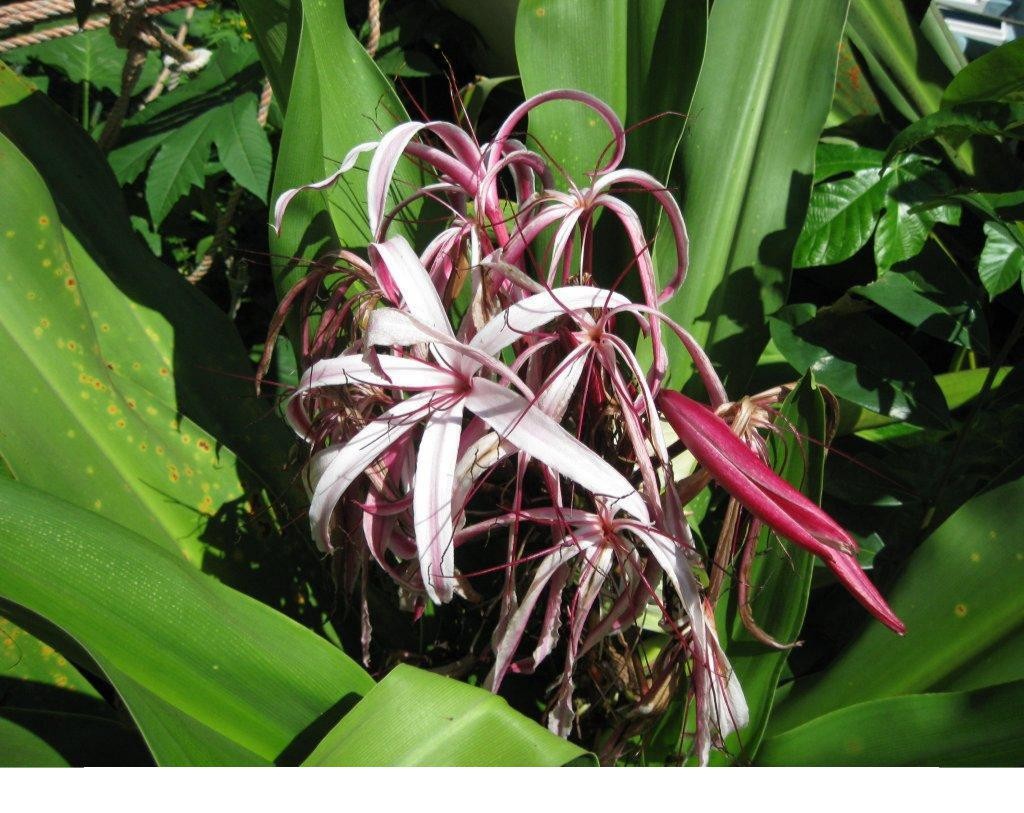By Tommy Clarkson from the February 2013 Edition
Crinum augustum (Queen Emma)
Family: Amaryllidaceas
(Also known as: Crinum, Crinum Lily, Cape Lily, River Lily,Mangrove Lily, Spider Lily, Milk Lily, Wine Lily or Spider Lily.)

Is mine, in fact, a Crinum augustum? It seems to meet the physical description criteria. The renowned tropical plant authority, W. Arthur Whistler, says it is native to the island states of Seychelles and Mauritius in the Indian Ocean. However, further research divulged that others believe the “Queen Emma” named for the wife of Hawaiian King Kamehameha IV is actually a cultivated variety from well Duh! Hawaii.
Regardless of this confusion, the first ones we acquired were found back off the coast several miles in the mountains of the southern part of the State of Jalisco. It happily grew in the front yard of a young Mexican couple with a darling little girl. When he observed me coveting his plant, the gracious young man though in his Sunday best and getting ready to go to Mass promptly knelt down and, with his bare hands, started to dig up several of its newly sprouted babies for me!
Substantive research has borne out that the origin of this outstanding looking lily is simply not clear. . . and I can but only wonder how it found its way up to this rather remote locale in Mexico! In fact, this may lend further credence to the belief by some that this plant is a naturally occurring hybrid of Crinum zeylanicum and some other species. Suffice it to say, confusion is rampant on this plant as the deeper one digs (pun probably intended) several other plants were found that are mistakenly described as Crinum augustum.
That all aside, let’s just go with what we do know of these attractive plants. In the genus Crinum, there are around 150 varieties of these tropical and sub-tropical beauties with only a few commercially available. They can be successfully used for borders, bedding plants or as a solitary feature plant. In the wild, Swamp Lilies are often found growing along lakes, in swamps, marshes, and estuaries but you might’ve already guessed that from the name, huh?
It is a perennial herb with an onion shaped bulb and erect, strap-like leaves which grow up to three or more feet in length and are three plus inches wide. Their very attractive six-petaled, flowers rise from the bulb on long flower stalks, separate from the leaves. Four of mine are tinged purple and smell like lilac. The other is wholly white. Both remind me of a grouping of Spider Orchids on steroids!
These long living plants can grow up to six to eight feet high in highly structural clumps in well-drained sandy soil. The pride of its existence (depending on the variety you have found) are those 20 to 30 large, lily-like red, white, pink, purple or bi-color flowers at the ends of long, stout stems.
I understand that in the wild, those tiny but loud mouthed little green tree frogs find homes in these clumps, and know for a fact that hummingbirds love their blossoms. It can tolerate poor soil as long as it’s cool hence mulching is good and has plenty of water to drink. For those you have planted, beyond copious agua, top dressing of compost or dried cow manure is much appreciated by them.
This Crinum Lilies flourishes in sun or partial shade. Ours thrive in full sun in large pots. Fertilize your Swamp Lily weekly during growth.
Lastly, the root a good wound poultice; heated and oiled leaves can be applied to sprains; and Australian aborigines crushed its stems and roots for application to marine, insect and jelly fish stings. A’hhhh, I’m a veritable fount of worthless, if not outright strange, minutia. But, perhaps ya’ never know the time might arise when you’ll need such nifty nuggets of knowledge!
Download the full edition or view it online
—
Tommy Clarkson is a bit of a renaissance man. He’s lived and worked in locales as disparate as the 1.2 square mile island of Kwajalein to war-torn Iraq, from aboard he and Patty’s boat berthed out of Sea Bright, NJ to Thailand, Germany, Hawaii and Viet Nam; He’s taught classes and courses on creative writing and mass communications from the elementary grades to graduate level; He’s spoken to a wide array of meetings, conferences and assemblages on topics as varied as Buddhism, strategic marketing and tropical plants; In the latter category he and Patty’s recently book, “The Civilized Jungle” – written for the lay gardener – has been heralded as “the best tropical plant book in the last ten years”; And, according to Trip Advisor, their spectacular tropical creation – Ola Brisa Gardens – is the “Number One Tour destination in Manzanillo”.




You must be logged in to post a comment.